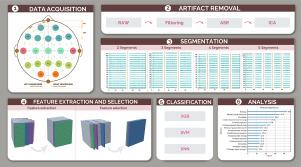利用脑电图完善多动症诊断:预处理和时间分割对分类准确性的影响
IF 7
2区 医学
Q1 BIOLOGY
引用次数: 0
摘要
背景:脑电信号通常用于诊断多动症,但它们经常受到噪声和伪影的影响。方法:我们对多动症儿童和神经典型对照组的脑电图数据应用了滤波、ASR 和 ICA 预处理技术。我们对脑电图记录进行了分割,并根据统计意义提取和选择了特征。结果:我们的研究结果表明,在较晚的脑电图片段上训练的模型准确率明显更高,这表明认知疲劳在区分多动症方面具有潜在的作用。使用来自 P3、P4 和 C3 通道的数据实现了最高的分类准确率(86.1%),而 Kurtosis、Katz 分形维度以及 Delta、Theta 和 Alpha 波段的功率谱等关键特征也对结果做出了贡献。结果表明,对认知疲劳和分割的进一步研究可提高多动症患者诊断的准确性。本文章由计算机程序翻译,如有差异,请以英文原文为准。

Refining ADHD diagnosis with EEG: The impact of preprocessing and temporal segmentation on classification accuracy
Background:
EEG signals are commonly used in ADHD diagnosis, but they are often affected by noise and artifacts. Effective preprocessing and segmentation methods can significantly enhance the accuracy and reliability of ADHD classification.
Methods:
We applied filtering, ASR, and ICA preprocessing techniques to EEG data from children with ADHD and neurotypical controls. The EEG recordings were segmented, and features were extracted and selected based on statistical significance. Classification was performed using various EEG segments and channels with Machine Learning models (SVM, KNN, and XGBoost) to identify the most effective combinations for accurate ADHD diagnosis.
Results:
Our findings show that models trained on later EEG segments achieved significantly higher accuracy, indicating the potential role of cognitive fatigue in distinguishing ADHD. The highest classification accuracy (86.1%) was achieved using data from the P3, P4, and C3 channels, with key features such as Kurtosis, Katz fractal dimension, and power spectrums in the Delta, Theta, and Alpha bands contributing to the results.
Conclusion:
This study highlights the importance of preprocessing and segmentation in improving the reliability of ADHD diagnosis through EEG. The results suggest that further research on cognitive fatigue and segmentation could enhance diagnostic accuracy in ADHD patients.
求助全文
通过发布文献求助,成功后即可免费获取论文全文。
去求助
来源期刊

Computers in biology and medicine
工程技术-工程:生物医学
CiteScore
11.70
自引率
10.40%
发文量
1086
审稿时长
74 days
期刊介绍:
Computers in Biology and Medicine is an international forum for sharing groundbreaking advancements in the use of computers in bioscience and medicine. This journal serves as a medium for communicating essential research, instruction, ideas, and information regarding the rapidly evolving field of computer applications in these domains. By encouraging the exchange of knowledge, we aim to facilitate progress and innovation in the utilization of computers in biology and medicine.
 求助内容:
求助内容: 应助结果提醒方式:
应助结果提醒方式:


